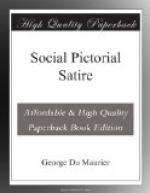But all these past manners and customs that some of us can remember so well—all these obsolete people, from the heavily whiskered swell to the policeman with the leather-bound chimney-pot hat, from good pater-and mater-familias who were actually looked up to and obeyed by their children, to the croquet-playing darlings in the pork-pie hats and huge crinolines—all survive and will survive for many a year in John Leech’s “Pictures of Life and Character.”
Except for a certain gentleness, kindliness, and self-effacing modesty common to both, and which made them appear almost angelic in the eyes of many who knew them, it would be difficult to imagine a greater contrast to Leech than Charles Keene.
Charles Keene was absolutely unconventional, and even almost eccentric. He dressed more with a view to artistic picturesqueness than to fashion, and despised gloves and chimney-pot hats, and black coats and broadcloth generally.
[Illustration: CHARLES KEENE
From a photograph by Elliott and Fry, London.]
Scotch tweed was good enough for him in town and country alike. Though a Tory in politics, he was democratic in his tastes and habits. He liked to smoke his short black pipe on the tops of omnibuses; he liked to lay and light his own fire and cook his mutton-chop upon it. He had a passion for music and a beautiful voice, and sang with a singular pathos and charm, but he preferred the sound of his bagpipes to that of his own singing, and thought that you must prefer it too!
He was for ever sketching in pen and ink, indoors and out—he used at one time to carry a little ink-bottle at his buttonhole, and steel pens in his waistcoat-pocket, and thus equipped he would sketch whatever took his fancy in his walks abroad—houses, ’busses, cabs, people—bits of street and square, scaffoldings, hoardings with advertisements—sea, river, moor, lake, and mountain—what has he not sketched with that masterly pen that had already been so carefully trained by long and arduous practice in a life-school? His heart was in his work from first to last; beyond his bagpipes and his old books (for he was a passionate reader), he seemed to have no other hobby. His facility in sketching became phenomenal, as also his knowledge of what to put in and what to leave out, so that the effect he aimed at should be secured in perfection and with the smallest appearance of labour.
Among his other gifts he had a physical gift of inestimable value for such work as ours—namely, a splendid hand—a large, muscular, well-shaped, and most workman-like hand, whose long deft fingers could move with equal ease and certainty in all directions. I have seen it at work—and it was a pleasure to watch its acrobatic dexterity, its unerring precision of touch. It could draw with nonchalant facility parallel straight lines, or curved, of just the right thickness and distance from each other—almost as regular as if they had been drawn with ruler or compass—almost, but not quite. The quiteness would have made them mechanical, and robbed them of their charm of human handicraft. A cunning and obedient slave, this wonderful hand, for which no command from the head could come amiss—a slave, moreover, that had most thoroughly learned its business by long apprenticeship to one especial trade, like the head and like the eye that guided it.




